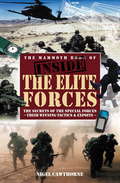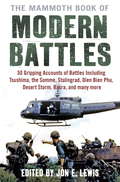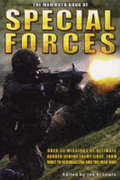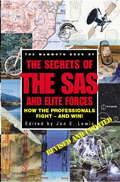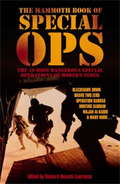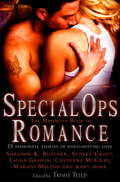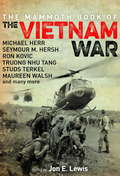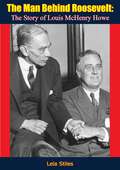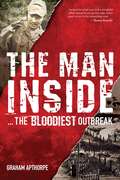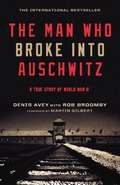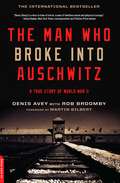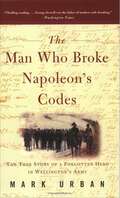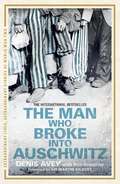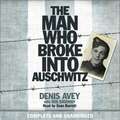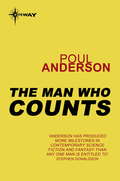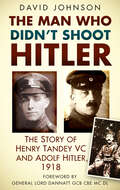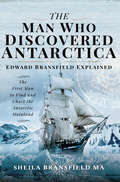- Table View
- List View
The Mammoth Book of Inside the Elite Forces (Mammoth Books #216)
by Nigel CawthorneThe most comprehensive and up-to-date guide to American and British special forces, covering all aspects of their equipment, training and deployment in the Iraq age of warfare. It takes a special kind of person to join the Special Forces and those to pass the stringent entrance requirements are subjected to the most rigorous training. They're trained to be super-fit, taught to survive in the most adverse conditions, and turned into killing machines. This book reveals what makes these men tick, and everything you need to know to become one of them. It covers all the types of training required - for fitness, combat, survival, navigation, communication, infiltration, interrogation, extraction and evasion. And it details the full array of weapons used, from small arms and knives to explosives and air back-up. Also included are full listings of all the units - including the SAS, Green Berets, SBS, Navy SEALs, Delta Force, Army Rangers - and their deployment in present-day conflicts such as Desert Storm, Somalia, Afghanistan, Iraq and anti-terrorist operations.
The Mammoth Book of Modern Battles (Mammoth Books #381)
by Jon E. LewisFrom the start of the 20th century to the most recent major offensives, here are fifty accounts of the battles that made the modern world, described in superb detail by historians and writers including John Keegan, Alan Clark, John Strawson, Charles Mey, John Pimlott, and John Laffin.All the major conflicts are covered, from two world wars, through Korea, Vietnam, Bosnia, Chechnya, to Iraq and Afghanistan. Among the battles featured are: the Somme, Passchendaele, Battle of Britain, Stalingrad, El Alamein, Monte Cassino, Omaha Beach, Iwa Jima, Dien Bien Phu, Ia Drang, Hamburger Hill, Desert Storm, Kabul, Baghdad, and Basra.
The Mammoth Book of Modern Battles (Mammoth Books)
by Jon E. LewisFrom the start of the 20th century to the most recent major offensives, here are fifty accounts of the battles that made the modern world, described in superb detail by historians and writers including John Keegan, Alan Clark, John Strawson, Charles Mey, John Pimlott, and John Laffin.All the major conflicts are covered, from two world wars, through Korea, Vietnam, Bosnia, Chechnya, to Iraq and Afghanistan. Among the battles featured are: the Somme, Passchendaele, Battle of Britain, Stalingrad, El Alamein, Monte Cassino, Omaha Beach, Iwa Jima, Dien Bien Phu, Ia Drang, Hamburger Hill, Desert Storm, Kabul, Baghdad, and Basra.
The Mammoth Book of SAS and Special Forces
by Jon E. LewisHere are thirty true and graphic accounts of the most heroic SAS and special-forces missions ever undertaken into the most dangerous place of all - behind enemy lines. Bang up to date, this unputdownable collection includes the most recent operations into Iraq in 2003, Afghanistan and Bosnia, and features the entire range of special forces from SAS, Commandos and Rangers to Navy SEALS and Paratroopers. Also included are several accounts that lift the veil - clandestine 'eyes-only' operations of ultimate danger, such as 1 SAS's attempted assassination of Rommel and 22 SAS's 'claret' raids into Indonesia in 1964. Each account is introduced by a mini-essay illustrating fascinating pieces of special-forces hardware, kit or training, such as SAS Evasion and Rescue training, the Accuracy International L96A1 sniper rifle and US Special Forces selection.
The Mammoth Book of SAS and Special Forces (Mammoth Books #386)
by Jon E. LewisHere are thirty true and graphic accounts of the most heroic SAS and special-forces missions ever undertaken into the most dangerous place of all - behind enemy lines. Bang up to date, this unputdownable collection includes the most recent operations into Iraq in 2003, Afghanistan and Bosnia, and features the entire range of special forces from SAS, Commandos and Rangers to Navy SEALS and Paratroopers. Also included are several accounts that lift the veil - clandestine 'eyes-only' operations of ultimate danger, such as 1 SAS's attempted assassination of Rommel and 22 SAS's 'claret' raids into Indonesia in 1964. Each account is introduced by a mini-essay illustrating fascinating pieces of special-forces hardware, kit or training, such as SAS Evasion and Rescue training, the Accuracy International L96A1 sniper rifle and US Special Forces selection.
The Mammoth Book of Secrets of the SAS & Elite Forces
by Jon E. LewisThe SAS have earned their reputation as the world's toughest fighting unit, from the Falklands War to Kosovo, the Gulf War and other crises elsewhere. This is a step-by-step guide to the tactics of such elite units, with true accounts of the SAS's most famous exploits, as well as those of crack US Army units such as Delta Force and the Green Berets. It includes: how the SAS and other elite units came into being and how they work; combat techniques in hostile environments, from the Sahara to the Artic; evasion, capture and escape routes; personal skills, including navigation, combat tracking and hazard avoidance; and wilderness survival skills.
The Mammoth Book of Secrets of the SAS & Elite Forces (Mammoth Books #387)
by Jon E. LewisThe SAS have earned their reputation as the world's toughest fighting unit, from the Falklands War to Kosovo, the Gulf War and other crises elsewhere. This is a step-by-step guide to the tactics of such elite units, with true accounts of the SAS's most famous exploits, as well as those of crack US Army units such as Delta Force and the Green Berets. It includes: how the SAS and other elite units came into being and how they work; combat techniques in hostile environments, from the Sahara to the Artic; evasion, capture and escape routes; personal skills, including navigation, combat tracking and hazard avoidance; and wilderness survival skills.
The Mammoth Book of Special Ops
by Richard Russell LawrenceInto the eye of danger with the men who put the 'special' in special forcesThe once shadowy activities of special forces have grown into an increasingly exposed element of 21st century warfare and anti-terrorist activity. Here, in one giant unputdownable volume, are 30 of the most dangerous special operations of modern times.Drawn from the flashpoints of the world, and above all Iraq and Afghanistan, these first-hand and reported accounts of missions by the SAS, Delta Force, Green Beret, Commandos and other forces will leave you on the edge of your seat.The accounts include:? Blackhawk Down - the US Delta forces debacle in Mogadishu, Somalia, 1993? British Special forces fight Al Qaeda at close quarters in Afghanistan 2003? Task Force Raider - US Special forces teams track down Saddam Hussein, 2003? The British 'Blackhawk Down' - Paras shoot their way out of trouble in Majar, Iraq 2003? The capture of insurgent leader Chemical Evil Fat Mama, Fallujah, November 2003
The Mammoth Book of Special Ops (Mammoth Books #359)
by Richard Russell LawrenceInto the eye of danger with the men who put the 'special' in special forcesThe once shadowy activities of special forces have grown into an increasingly exposed element of 21st century warfare and anti-terrorist activity. Here, in one giant unputdownable volume, are 30 of the most dangerous special operations of modern times.Drawn from the flashpoints of the world, and above all Iraq and Afghanistan, these first-hand and reported accounts of missions by the SAS, Delta Force, Green Beret, Commandos and other forces will leave you on the edge of your seat.The accounts include: Blackhawk Down - the US Delta forces debacle in Mogadishu, Somalia, 1993 British Special forces fight Al Qaeda at close quarters in Afghanistan 2003 Task Force Raider - US Special forces teams track down Saddam Hussein, 2003 The British 'Blackhawk Down' - Paras shoot their way out of trouble in Majar, Iraq 2003 The capture of insurgent leader Chemical Evil Fat Mama, Fallujah, November 2003
The Mammoth Book of Special Ops Romance
by Trisha TelepStirring romance featuring the heroes of the Navy SEALs, Delta Force, Air Force Pararescue, the Green Berets, the Army Rangers and other special forces: men and women who live and fight in extreme danger to preserve our freedoms, defenders and protectors of all we hold dear. This collection includes the work of bestselling romance writers such as Shannon K. Butcher and Stephanie Tyler and Larissa Ione, writing as Sydney Croft. Sydney Croft's special forces couple, Annika and Creed, work for the Agency for Covert Rare Operatives (ACRO), all of whose members have special powers, while Shannon K. Butcher's hero is an ex-Navy SEAL. But these fighting men and women have a gentler, protective side; hard-edged weapons when on active duty, they can be caring lovers, of special forces teammates or the civilians they protect.
The Mammoth Book of Special Ops Romance (Mammoth Books #448)
by Trisha TelepStirring romance featuring the heroes of the Navy SEALs, Delta Force, Air Force Pararescue, the Green Berets, the Army Rangers and other special forces: men and women who live and fight in extreme danger to preserve our freedoms, defenders and protectors of all we hold dear. This collection includes the work of bestselling romance writers such as Shannon K. Butcher and Stephanie Tyler and Larissa Ione, writing as Sydney Croft. Sydney Croft's special forces couple, Annika and Creed, work for the Agency for Covert Rare Operatives (ACRO), all of whose members have special powers, while Shannon K. Butcher's hero is an ex-Navy SEAL. But these fighting men and women have a gentler, protective side; hard-edged weapons when on active duty, they can be caring lovers, of special forces teammates or the civilians they protect.
The Mammoth Book of the Vietnam War (Mammoth Books #390)
by Jon E. LewisBy 1969, following the French defeat at Dien Bien Phu, over 500,000 US troops were ‘in country’ in Vietnam. Before America’s longest war had ended with the fall of Saigon in 1975, 450,000 Vietnamese had died, along with 36,000 Americans. The Vietnam War was the first rock ’n’ roll war, the first helicopter war with its doctrine of ‘airmobility’, and the first television war; it made napalm and the defoliant Agent Orange infamous, and gave us the New Journalism of Michael Herr and others. It also saw the establishment of the Navy SEALs and Delta Force. At home, America fractured, with the peace movement protesting against the war; at Kent State University, Ohio National Guardsmen fired on unarmed students, killing four and injuring nine. Lewis’s compelling selection of the best writing to come out of a war covered by some truly outstanding writers, both journalists and combatants, includes an eyewitness account of the first major battle between the US Army and the People’s Army of Vietnam at Ia Drang; a selection of letters home; Nicholas Tomalin’s famous ‘The General Goes Zapping Charlie Cong’; Robert Mason’s ‘R&R’, Studs Terkel’s account of the police breaking up an anti-war protest; John Kifner on the shootings at Kent State; Ron Kovic’s ‘Born on the Fourth of July’; John T. Wheeler’s ‘Khe Sanh: Live in the V Ring’; Pulitzer Prize-winner Seymour Hersh on the massacre at My Lai; Michael Herr’s ‘It Made You Feel Omni’; Viet Cong Truong Nhu Tang’s memoir; naval nurse Maureen Walsh’s memoir, ‘Burning Flesh’; John Pilger on the fall of Saigon; and Tim O’Brien’s ‘If I Die in a Combat Zone’.
The Mammoth Book of the Vietnam War (Mammoth Books)
by Jon E. LewisBy 1969, following the French defeat at Dien Bien Phu, over 500,000 US troops were 'in country' in Vietnam. Before America's longest war had ended with the fall of Saigon in 1975, 450,000 Vietnamese had died, along with 36,000 Americans. The Vietnam War was the first rock 'n' roll war, the first helicopter war with its doctrine of 'airmobility', and the first television war; it made napalm and the defoliant Agent Orange infamous, and gave us the New Journalism of Michael Herr and others. It also saw the establishment of the Navy SEALs and Delta Force. At home, America fractured, with the peace movement protesting against the war; at Kent State University, Ohio National Guardsmen fired on unarmed students, killing four and injuring nine. Lewis's compelling selection of the best writing to come out of a war covered by some truly outstanding writers, both journalists and combatants, includes an eyewitness account of the first major battle between the US Army and the People's Army of Vietnam at Ia Drang; a selection of letters home; Nicholas Tomalin's famous 'The General Goes Zapping Charlie Cong'; Robert Mason's 'R&R', Studs Terkel's account of the police breaking up an anti-war protest; John Kifner on the shootings at Kent State; Ron Kovic's 'Born on the Fourth of July'; John T. Wheeler's 'Khe Sanh: Live in the V Ring'; Pulitzer Prize-winner Seymour Hersh on the massacre at My Lai; Michael Herr's 'It Made You Feel Omni'; Viet Cong Truong Nhu Tang's memoir; naval nurse Maureen Walsh's memoir, 'Burning Flesh'; John Pilger on the fall of Saigon; and Tim O'Brien's 'If I Die in a Combat Zone'.
The Man Behind Roosevelt: The Story of Louis McHenry Howe
by Lela StilesOriginally published in 1954, this book tells the story of Louis McHenry Howe (1871-1936), an American reporter for the New York Herald who became best known for acting as an early political advisor to President Franklin D. Roosevelt.Affectionately referred to as “the little boss,” he would play an important part behind the scenes in shaping the destiny of the man who four times became President of the United States.“THIS BIOGRAPHY of Louis Howe is delightfully written and has the advantage of giving a number of stories which I am sure would never have been printed unless someone close to the work Louis did had undertaken to write it. The sidelights on the relationship between my husband and Louis and what this relationship meant to my husband’s public life in the early days and in the struggles of his future life will, I think, be a valuable contribution to history. There has seldom been a story of greater devotion to another man’s success but at the same time one realizes that this was not due to any lack of ambition on the part of Louis McHenry Howe. He loved power, but he also recognized realities and he decided that in the end he would exercise more power through someone else and he prided himself on the judgment he used in choosing the individual with whom and for whom he was going to work.“Lela Stiles shows discrimination and powers of observation which mark her as a real reporter. I found her book delightful reading.”—ELEANOR ROOSEVELT, Foreword, The Man Behind Roosevelt: The Story of Louis McHenry Howe
The Man Inside: The Bloodiest Outbreak
by Graham ApthorpeThe War in the Pacific has turned; thousands of the previously invincible Japanese soldiers are now being captured in New Guinea and interned at the Cowra Prisoner of War Camp. Unlike other POWs, the traditional Japanese Bushido Code and their fanaticism leaves them ill-equipped for surrender and imprisonment. Ashamed, subdued and sullen, one man, Second Lieutenant Maseo Naka is an exception. Obstructing the Australian authorities at every turn, he was the first Japanese soldier to escape from Cowra. This action becomes the precursor for the more than 1000 Japanese prisoners who escape in the bloodiest Breakout of World War II that ultimately saw 234 Japanese and four Australian guards killed. His escape and the defiance, guilt, and shame that motivated it, led to his court-martial. Naka nevertheless stands-out as very human, another tragic victim of the global inferno that was World War II. Adhering to the Samurai Code of Bushido, he doggedly undertakes actions that he views as necessary for the maintenance of his &“honour&”. Through the insights of those around Naka, together with new research including the personal accounts of Australian interrogators, the author shows how this handsome loner provided the impetus for the dramatic events in the early hours of August 5, 1944 where hundreds of Japanese soldiers stormed the Camp defences for honour, or death!
The Man Who Broke Into Auschwitz
by Denis Avey Rob BroombyThe Man Who Broke into Auschwitz is the extraordinary true story of a British soldier who marched willingly into the concentration camp, Buna-Monowitz, known as Auschwitz III. In the summer of 1944, Denis Avey was being held in a British POW labour camp, E715, near Auschwitz III. He had heard of the brutality meted out to the prisoners there and he was determined to witness what he could. He hatched a plan to swap places with a Jewish inmate and smuggled himself into his sector of the camp. He spent the night there on two occasions and experienced at first-hand the cruelty of a place where slave workers, had been sentenced to death through labor. Astonishingly, he survived to witness the aftermath of the Death March where thousands of prisoners were murdered by the Nazis as the Soviet Army advanced. After his own long trek right across central Europe he was repatriated to Britain. For decades he couldn't bring himself to revisit the past that haunted his dreams, but now Denis Avey feels able to tell the full story--a tale as gripping as it is moving--which offers us a unique insight into the mind of an ordinary man whose moral and physical courage are almost beyond belief.
The Man Who Broke Into Auschwitz
by Denis Avey Rob BroombyTHE MAN WHO BROKE INTO AUSCHWITZ is the extraordinary true story of a British soldier who marched willingly into Buna-Monowitz, the concentration camp known as Auschwitz III. In the summer of 1944, Denis Avey was being held in a POW labour camp, E715, near Auschwitz III. He had heard of the brutality meted out to the prisoners there and he was determined to witness what he could. He hatched a plan to swap places with a Jewish inmate and smuggled himself into his sector of the camp. He spent the night there on two occasions and experienced at first-hand the cruelty of a place where slave workers, had been sentenced to death through labour. Astonishingly, he survived to witness the aftermath of the Death March where thousands of prisoners were murdered by the Nazis as the Soviet Army advanced. After his own long trek right across central Europe he was repatriated to Britain. For decades he couldn't bring himself to revisit the past, but now Denis Avey feels able to tell the full story - a tale as gripping as it is moving - which offers us a unique insight into the mind of an ordinary man whose moral and physical courage are almost beyond belief.
The Man Who Broke Into Auschwitz: A True Story of World War II
by Denis Avey Rob BroombyThe Man Who Broke into Auschwitz is the extraordinary true story of a British soldier who marched willingly into the concentration camp, Buna-Monowitz, known as Auschwitz III. In the summer of 1944, Denis Avey was being held in a British POW labour camp, E715, near Auschwitz III. He had heard of the brutality meted out to the prisoners there and he was determined to witness what he could. He hatched a plan to swap places with a Jewish inmate and smuggled himself into his sector of the camp. He spent the night there on two occasions and experienced at first-hand the cruelty of a place where slave workers, had been sentenced to death through labor. Astonishingly, he survived to witness the aftermath of the Death March where thousands of prisoners were murdered by the Nazis as the Soviet Army advanced. After his own long trek right across central Europe he was repatriated to Britain. For decades he couldn't bring himself to revisit the past that haunted his dreams, but now Denis Avey feels able to tell the full story--a tale as gripping as it is moving--which offers us a unique insight into the mind of an ordinary man whose moral and physical courage are almost beyond belief.
The Man Who Broke Napoleon's Codes: The True Story of a Forgotten Hero in Wellington's Army
by Mark UrbanThe little-known story of a brilliant British code-cracker: &“[Urban] has pieced together the fragments and deciphered the truth about a hidden hero.&” —Daily Telegraph The Duke of Wellington—who began his military career as Arthur Wellesley—is rightly credited for the strategic and intelligence-gathering brilliance that culminated in Britain&’s defeat of Napoleon at Waterloo. Two centuries later, many of his subordinates are still remembered for their roles in these historic campaigns. But Lt. Col. George Scovell is not among them. This is the story of a man of common birth—bound, according to the severe social strictures of eighteenth-century England, for the life of a tradesman—who would become his era&’s most brilliant code-breaker and an officer in Wellesley&’s army. In an age when officers were drawn almost exclusively from the ranks of the nobility, George Scovell—an engraver&’s apprentice—joined Wellesley in 1809. Scovell provides a fascinating lens through which to view a critical era in military history—his treacherous rise through the ranks despite the scorn of his social betters, and his presence alongside Wellesley in each of the major European campaigns from the Iberian Peninsula through Waterloo. But Scovell was more than just a participant in those events. Already recognized as a gifted linguist, Scovell would prove a remarkably nimble cryptographer. Encoded communiqués between Napoleon and his generals, intercepted by the British, were brought to Scovell for his skilled deciphering. As Napoleon&’s encryption techniques became more sophisticated, Wellesley came to rely ever more on Scovell&’s genius for this critical intelligence. In Scovell&’s lifetime, his role in Britain&’s greatest military victory was grudgingly acknowledged, but his accomplishments would eventually be credited to others—including Wellington himself. His name—and contributions—have been largely overlooked.The Man Who Broke Napoleon&’s Codes tells the fascinating story of the early days of cryptology, re-creates the high drama of some of Europe&’s most remarkable military campaigns, and restores the mantle of hero to a man heretofore forgotten by history. &“Combine[s] the fast-paced narrative of a spy novel with colorful period detail describing the inner workings of an army staff at war.&” —Library Journal &“Thrilling reading.&” —The Washington Times
The Man Who Broke into Auschwitz: The Extraordinary True Story (Extraordinary Lives, Ext Ser.)
by Denis Avey Rob BroombyTHE INTERNATIONAL BESTSELLERTHE MAN WHO BROKE INTO AUSCHWITZ is the extraordinary true story of a British soldier who marched willingly into Buna-Monowitz, the concentration camp known as Auschwitz III.In the summer of 1944, Denis Avey was being held in a POW labour camp, E715, near Auschwitz III. He had heard of the brutality meted out to the prisoners there and he was determined to witness what he could. He hatched a plan to swap places with a Jewish inmate and smuggled himself into his sector of the camp. He spent the night there on two occasions and experienced at first-hand the cruelty of a place where slave workers, had been sentenced to death through labour. Astonishingly, he survived to witness the aftermath of the Death March where thousands of prisoners were murdered by the Nazis as the Soviet Army advanced. After his own long trek right across central Europe he was repatriated to Britain. For decades he couldn't bring himself to revisit the past, but now Denis Avey feels able to tell the full story - a tale as gripping as it is moving - which offers us a unique insight into the mind of an ordinary man whose moral and physical courage are almost beyond belief.
The Man Who Broke into Auschwitz: The Extraordinary True Story (Extraordinary Lives, Extraordinary Stories of World War Two #8)
by Denis Avey Rob BroombyTHE INTERNATIONAL BESTSELLERTHE MAN WHO BROKE INTO AUSCHWITZ is the extraordinary true story of a British soldier who marched willingly into Buna-Monowitz, the concentration camp known as Auschwitz III.In the summer of 1944, Denis Avey was being held in a POW labour camp, E715, near Auschwitz III. He had heard of the brutality meted out to the prisoners there and he was determined to witness what he could. He hatched a plan to swap places with a Jewish inmate and smuggled himself into his sector of the camp. He spent the night there on two occasions and experienced at first-hand the cruelty of a place where slave workers, had been sentenced to death through labour. Astonishingly, he survived to witness the aftermath of the Death March where thousands of prisoners were murdered by the Nazis as the Soviet Army advanced. After his own long trek right across central Europe he was repatriated to Britain. For decades he couldn't bring himself to revisit the past, but now Denis Avey feels able to tell the full story - a tale as gripping as it is moving - which offers us a unique insight into the mind of an ordinary man whose moral and physical courage are almost beyond belief.
The Man Who Broke into Auschwitz: The Extraordinary True Story (Extraordinary Lives, Extraordinary Stories of World War Two #8)
by Denis Avey Rob BroombyTHE MAN WHO BROKE INTO AUSCHWITZ is the extraordinary true story of a British soldier who marched willingly into Buna-Monowitz, the concentration camp known as Auschwitz III.In the summer of 1944, Denis Avey was being held in a POW labour camp, E715, near Auschwitz III. He had heard of the brutality meted out to the prisoners there and he was determined to witness what he could. He hatched a plan to swap places with a Jewish inmate and smuggled himself into his sector of the camp. He spent the night there on two occasions and experienced at first-hand the cruelty of a place where slave workers, had been sentenced to death through labour. Astonishingly, he survived to witness the aftermath of the Death March where thousands of prisoners were murdered by the Nazis as the Soviet Army advanced. After his own long trek right across central Europe he was repatriated to Britain. For decades he couldn't bring himself to revisit the past that haunted his dreams, but now Denis Avey feels able to tell the full story - a tale as gripping as it is moving - which offers us a unique insight into the mind of an ordinary man whose moral and physical courage are almost beyond belief. (P)2011 Hodder & Stoughton
The Man Who Counts: Polesotechnic League Book 1 (POLESOTECHNIC LEAGUE)
by Poul AndersonNicholas Van Rijn: Interstellar Merchant Prince one moment, barbarian chattel the next. Marooned half a world and an ocean away from the sole human outpost on a planet whose very water is poisonous to humans; captured by winged barbarians in the midst of a brutal war of extermination, somehow 'Old Nick' must scheme, conspire, wrangle and battle his way to survival.
The Man Who Didn't Shoot Hitler: The Story of Henry Tandey VC and Adolf Hitler, 1918
by David JohnsonThis is the tale of two men.The first is Henry Tandey, an ordinary man later deemed to be ‘a hero of the old berserk type’, born and brought up in Leamington Spa, Warwickshire, who displayed extraordinary courage to emerge from the First World War as the most decorated British private to survive. The second is Adolf Hitler, who was highly decorated in his service to Germany in the First World War and went on to become one of the most infamous dictators in history, later bringing the world to the brink of destruction during the Second World War. It seems unlikely that their fates should collide. Yet in 1938 Hitler named Tandey as the soldier who spared his life on 28 September 1918 in the aftermath of the Battle of Marcoing – an assertion that came as a surprise to Tandey himself. The Man Who Didn’t Shoot Hitler tells the story of Tandey’s and Hitler’s Great War, the moment when their lives became intertwined – if in fact they did – and how Tandey lived with the stigma of being known not for his chestful of medals for gallantry in service of King and Country, but as the man who let Hitler live.
The Man Who Discovered Antarctica: Edward Bransfield Explained: The First Man to Find and Chart the Antarctic Mainland
by Sheila BransfieldThe definitive biography of the British naval officer who found the Antarctic shoreline in the early nineteeth century. Captain Cook claimed the honor of being the first man to sail into the Antarctic Ocean in 1773, which he circumnavigated the following year. Cook, though, did not see any land, and declared that there was no such thing as the Southern Continent. Fifty years later, an Irishman who&’d been impressed into the Royal Navy at eighteen, and risen through the ranks to the position of master, proved Cook wrong, discovering and charting parts of the Antarctic shoreline. He also discovered Elephant Island and Clarence Island, claiming them for the British Crown. Edward Bransfield&’s naval career included taking part in the Bombardment of Algiers in 1816 onboard the 50-gun warship HMS Severn. Then, in 1817, he was posted to the Royal Navy&’s Pacific Squadron off Valparaíso in Chile, and it was while he served there that the skipper of an English whaling ship, the Williams, was driven south by adverse winds and discovered what came to be known as the South Shetland Islands where Cook had said there was no land. Bransfield&’s superior officer, Captain Sherriff, decided to investigate further. He chartered Williams and sent Bransfield with two midshipmen and a ship&’s surgeon into the Antarctic—and the Irishman sailed into history. Despite many parts of Antarctica and an Antarctic survey vessel being named after him, and a Royal Mail commemorative stamp issued in his name, the full story of this remarkable man and his historic journey, have never been told—until now. Following decades of research, Sheila Bransfield MA, a member of the UK Antarctic Heritage Trust, has produced the definitive biography of one of Britain&’s greatest maritime explorers. The book also includes a foreword by the Trust&’s patron the Princess Royal. &“Bransfield&’s meticulous research gives us a detailed account of the daily routines of the Navy and the immense amount of maintenance required of a large wooden warship in the Age of Sail.&” —Historical Novel Society
